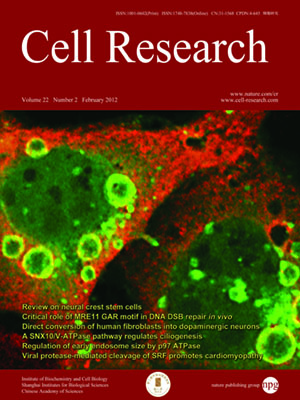
Advanced Search
Submit Manuscript
Advanced Search
Submit Manuscript
Volume 22, No 2, Feb 2012
ISSN: 1001-0602
EISSN: 1748-7838 2018
impact factor 17.848*
(Clarivate Analytics, 2019)
Volume 22 Issue 2, February 2012: 372-386
Zhenyi Zhang1,2,*, Leyi Chen1,2,*, Lei Gao1,2,*, Kui Lin1,2,*, Liang Zhu1,2,4, Yang Lu1, Xiaoshan Shi1,3, Yuan Gao1,2, Jing Zhou1,2, Ping Xu1
1State Key Laboratory of Microbial Metabolism, and School of Life Sciences & Biotechnology, Shanghai Jiao Tong University, Shanghai 200240, China
2Key Laboratory of MOE for Developmental Genetics and Neuropsychiatric Diseases, Shanghai Jiao Tong University, Shanghai 200240, China
3Institute of Biochemistry and Cell Biology, Shanghai Institutes for Biological Sciences, Chinese Academy of Sciences, Shanghai 200031, China
4Department of Pathophysiology, Key Laboratory of Cell Differentiation and Apoptosis of Chinese Ministry of Education, Shanghai Jiao-Tong University School of Medicine (SJTU-SM), Shanghai 200025, China
Correspondence: Geng Wu, Kui Lin, Jian Zhang,(geng.wu@sjtu.edu.cn; klin@sjtu.edu.cn; bjian.zhang@sjtu.edu.jian.zhang@sjtu.edu.cn)
Adenomatous polyposis coli (APC) regulates cell-cell adhesion and cell migration through activating the APC-stimulated guanine nucleotide-exchange factor (GEF; Asef), which is usually autoinhibited through the binding between its Src homology 3 (SH3) and Dbl homology (DH) domains. The APC-activated Asef stimulates the small GTPase Cdc42, which leads to decreased cell-cell adherence and enhanced cell migration. In colorectal cancers, truncated APC constitutively activates Asef and promotes cancer cell migration and angiogenesis. Here, we report crystal structures of the human APC/Asef complex. We find that the armadillo repeat domain of APC uses a highly conserved surface groove to recognize the APC-binding region (ABR) of Asef, conformation of which changes dramatically upon binding to APC. Key residues on APC and Asef for the complex formation were mutated and their importance was demonstrated by binding and activity assays. Structural superimposition of the APC/Asef complex with autoinhibited Asef suggests that the binding between APC and Asef might create a steric clash between Asef-DH domain and APC, which possibly leads to a conformational change in Asef that stimulates its GEF activity. Our structures thus elucidate the molecular mechanism of Asef recognition by APC, as well as provide a potential target for pharmaceutical intervention against cancers.
Cell Research (2012) 22:372-386. doi:10.1038/cr.2011.119; published online 26 July 2011